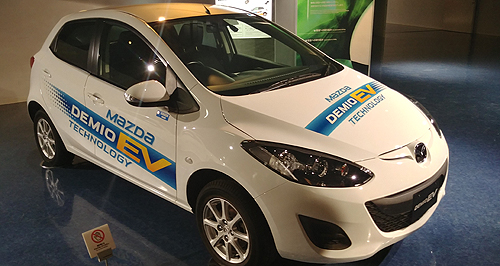Tokyo show: Mazda plots EV course
BY TUNG NGUYEN | 30th Oct 2017

Mazda Motor Corporation managing executive officer in charge of powertrain and vehicle development and product planning Ichiro Hirose told Australian journalists at the Tokyo motor show last week that the plug-in hybrid would be joined by an already-confirmed rotary range-extending electric vehicle and a full EV.
The latter is due in 2021 and will be a product of Mazda’s joint venture with Toyota and Denso.
According to Mr Hirose, most of Mazda’s model range will feature at least one electrified powertrain option by the end of next decade, but the brand will not forgo development of the combustion engines.
“Around the 2030 timing, I think all of our vehicles will offer internal combustion engines, but they will all have some level of electrification technologies combined with them – that’s the plan,” he said.
“So although we said we are going to apply electrification technologies onto our cars, before we do that we will make sure we will sophisticate and improve the internal combustion engine to the utmost levels and combine the electrification technologies with those internal combustion engines.
“We are hoping that we will be able to prepare enough engine line-up which can cover the product we are offering entirely.”Although Mazda currently offers its Mazda3 small car with electrification in its home market, the SkyActiv-Hybrid technology borrows from Toyota’s Hybrid Synergy Drive technology.
Mazda Motor Corporation senior technical fellow in charge of technical research centre and integrated control system development Mitsuo Hitomi added that the Hiroshima-based car-maker would use future electric powertrain technologies differently from its competitors.
Mr Hitomi said most manufacturers make use of electric drivetrains once the vehicle is already up in the power band, usually at consistent cruising speeds with excess torque used to recharge the battery.
“So you need very high precision control to get this efficiency, but the downside is you would need a huge motor and huge battery as well to achieve this,” he said.
On the other hand, Mazda is aiming to have its electric system kick in at low engine speeds to take advantage of instantaneous torque available from such a set-up, according to Mr Hitomi.
“What does that mean? Because the fuel-efficient range is very broad … the only assist we need from electrification is very narrow in this area,” he said.
“In terms of total efficiency, if we can have this and just assistance in the low area it means small motors, very small battery, very high efficiency in the end.”Systems used by the Toyota Prius and BMW i8 pair low-displacement engines – a 1.8-litre four-cylinder and 1.5-litre turbo three-cylinder respectively – with a cutting-edge electric motor for propulsion.
Mazda will instead reverse this relationship and pair its high-compression SkyActiv engines with a cheaper electric solution for an overall more affordable plug-in hybrid, Mr Hitomi said.
“They have low cost in the engine, higher costs on hybridisation … but the important part is total cost,” he said. “It’s going to be lower here in the long run.”